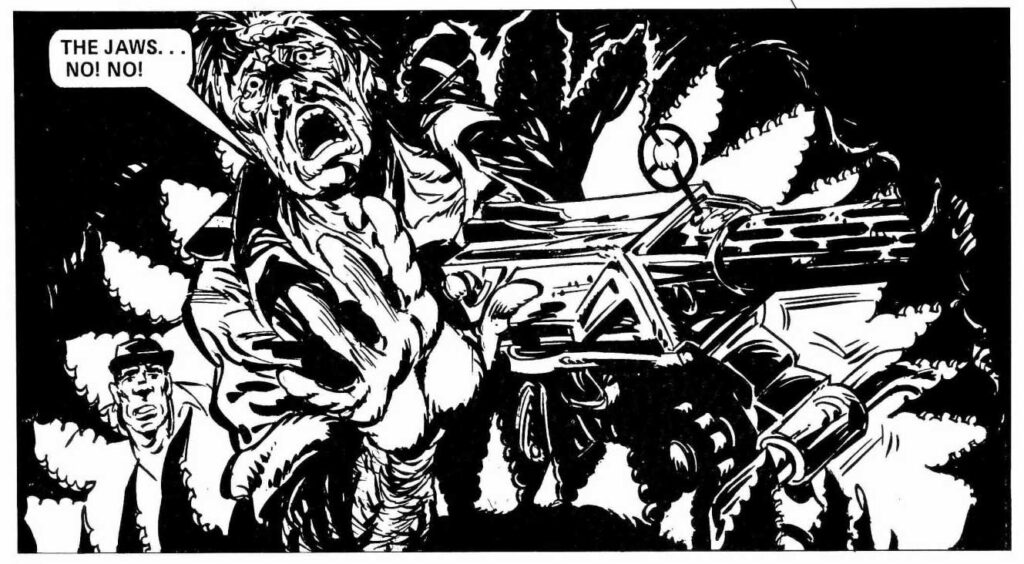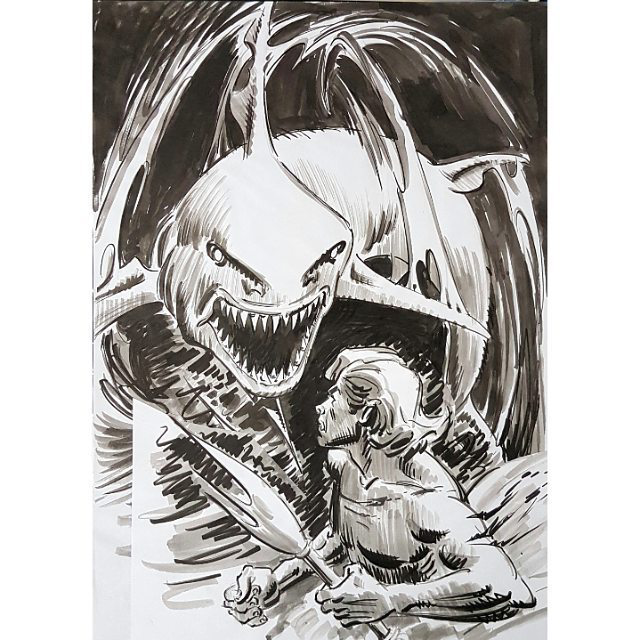Throughout Action’s history, “Hook Jaw” was consistently the most popular story. In many ways it became the symbol of the comic. Action equalled “Hook Jaw” equalled Action. It was also one of the few stories to survive right through the Second Series, as the publishers tried desperately to hang on to a swiftly declining readership.

Scripts were written by Ken Armstrong, a staff man at IPC. Who left the company in the late 1970s and disappeared from the comics business. It was drawn in the early days by Ramon Sola, one of the Barcelona school of artists, who did a lot of work for both IPC and DC Thomson in this period. Sola first worked on the girls’ comics like Valentine in 1974. He was approached by Mills, and asked to submit sample work for “Hook Jaw”. In the early days. his artwork was quite extensively subedited, but he quickly learnt the style required. Sola remained the artist for about 15 issues, after moving to London in 1975. But then he moved out of comic work altogether into illustration of various kinds. with which he was happier.
Sola’s instructions from Mills were clear. Hook Jaw was to be “the star of the story” – the exact opposite of the Jaws films, where the shark is just an anonymous threat (a fact that has allowed some bizarre Freudian interpretations of the films). In “Hook Jaw”, we can see both the truth and falsity of Geoff Kemp’s description of it as a typical “death crib”
In the sense that the whole reason for doing a shark s1ory was because of the popularity of the films. yes. But in the sense of being jus1 a copy, no. As Jack Adrian put it, very often the pulp writer takes over someone else’s themes and sees away to do it better. An awful lot of what we are now asked to think of as Great Literature (including Shakespeare) came about in this way.
The Action formula got hold of the shark-theme, and added several things of its own. In 1he comic we could follow the shark, be aware of its reactions, its instinctual responses, and its simple repertoire of desires and hates. Then there was a distanced pleasure at being shocked.
There is something significant in a cover headline that can say: “Be eaten alive by Hook Jaw”, or “Commit suicide with Hook Jaw”. It tells us something about the special way readers were threatened by this monster from the deeps. For example, they send down a diver in a reinforced cage, sure that Hook Jaw can’t get through the bars. What comes along? A school of Hookjaw’s sproglets, all just small enough 10 gel through 1hc bars and eat the diver, small piece by small piece. The films wouldn’t have done it like that – they would have had the cameras inside the bars, and the baby sharks would have seemed 10 come right at us. A comic has to work differently. It works by giving us a sense of horrifying possibilities. The comic couldn’t shock us the way the film could. but it could provide a special shiver as we realise this could happen.
The third difference in Action‘s treatment of the shark-idea was in their portryal of human villains. Right from the start, Hook Jaw is given a reason to hate humans. The gaffe stuck in his snout was an eternal reminder of fat humans and their interference with his legitimate hungers. From then on, who is he up against, but vicious, greedy people? An oilman who will sacrifice rig-workers lives to Hook Jaw, for the sake of profit. An island property developer quite prepared to lie, beat people up, have people die in Hook Jaw’s dentures rather than risk the profits from his island paradise. This is surely the reason Pat Mills called the story “ecological”. Only the humans are the pollutants. And the shark is the innocent party.
From early on, Hook Jaw’s overwhelming popularity ensured it centre pages and therefore colour. It was this which gave rise to the occasion when, leaning over the open plan parition in the editorial office, a senior manager was heard to tell a busy colourist: “What’s going on on this page? It’s a bit boring. Put more blood in there, I want 10 see more blood.” And why not? The whole point of the story was the grossness of Hook Jaw’s predations. lnteresting then, that one of the first acts of the new editor Sid Bicknell was to take Hook Jaw off the centre pages. In its place went a revised “Look out for Lefty”. To “Lefty”, it really made little difference. except that he could now appear something like QPR ‘s colours. “Hook Jaw” without the blood showing was like meat without gravy.
Hook Jaw Bonus!

Read More in this Section of “Sevenpenny Nightmare”
The Excerpts: Action: The Story of a Violent Comic (about the book by Martin Barker) | Action: The Story of a Violent Comic – Introduction | Developing the Formula | The Critics Bite Back | Moving in for the Kill | So, Should Action Have Been Censored? | Action: The Story of a Violent Comic – Reader Survey | Hook Jaw: The Shark Bites Back | The Lost Pages of Hook Jaw – TO BE ADDED | How Lefty Lost His Bottle – TO BE ADDED | The Lost Pages of Lefty – TO BE ADDED | Death Game 1999: Steel Balls to the Finish | The Lost Pages of Death Game 1999 – TO BE ADDED | When The Crumblies Flipped It: Kids Rule OK…? | The Lost Pages of Kids Rule O.K. | Dredger… No Comment | The Final Reckoning | Estimating Action
Sevenpenny Nightmare Section Index
This is an excerpt from Action: The History of a Violent Comic by Martin Barker, featured here as part of the Sevenpenny Nightmare project edited by Moose Harris. Text © Martin Barker.
ACTION™ REBELLION PUBLISHING LTD, COPYRIGHT © REBELLION PUBLISHING LTD, ALL RIGHTS RESERVED.
See this section’s Acknowledgments section for more information